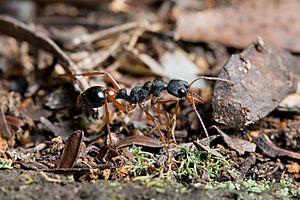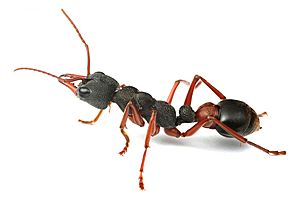Tasmanian inchman facts for kids
Quick facts for kids Myrmecia esuriens |
|
|---|---|
 |
|
| Scientific classification | |
| Kingdom: | |
| Phylum: | |
| Class: | |
| Order: | |
| Family: | |
| Subfamily: |
Myrmeciinae
|
| Genus: | |
| Species: |
M. esuriens
|
| Binomial name | |
| Myrmecia esuriens Fabricius, 1804
|
|
The Tasmanian inchman, also called Myrmecia esuriens, is a type of bulldog ant. These ants live only in Tasmania, an island in Australia.
Contents
What Does the Tasmanian Inchman Look Like?
The biggest ants in this species are the queens. They can be about 22 to 24 millimeters (almost an inch) long! Male ants, sometimes called "drones," grow to about 16 millimeters. The worker ants are usually between 14 and 18 millimeters long. This makes the Tasmanian inchman a medium-sized ant compared to other Myrmecia ants, which can range from 6 to over 30 millimeters.
Body Colors and Hair
Most of the ant's body is black. However, one part of its belly, called the postpetiole, is a bright orange-red. Their strong jaws (mandibles), feelers (antennae), and legs are also orange-red. They have yellow hair, which is short on their head, chest, and legs. The hair is longer on their main body part, called the gaster.
Special Features
The Tasmanian inchman has long, straight jaws with 11 teeth. They also have very good eyesight. This helps them find food and defend their nest when they are outside.
Something special about these ants is that their queens do not have wings. Most ant queens have wings when they are young. Because these queens look more like workers, they are called ergatoid queens. This is one reason why the Myrmecia group of ants is thought to be quite old in terms of ant evolution.
Where Do Tasmanian Inchman Ants Live?
The Tasmanian inchman is found only in Tasmania. They live in forests, rocky areas, and places with lots of plants. You can often find their nests under rocks or fallen trees. They build their nests in the soil, sometimes covering them with small stones or plants.
How Do Tasmanian Inchman Ants Behave?
Worker ants search for food on the ground and in low plants. They like to eat sweet things like nectar. But they also hunt and collect other small creatures to feed to the ant larvae (baby ants).
Nest Defense and Stings
Bulldog ants are known for being very protective of their nests. If they feel threatened, they will sting and use their strong jaws to fight off attackers.
The Tasmanian inchman is related to the jack jumper ant, which has a sting that can be dangerous to people who are very allergic to it. While the Tasmanian inchman also stings, there are no reports of its sting being harmful to humans. The sting can be painful, but people say the pain usually doesn't last long.
In rural Tasmania, some people use a folk remedy for the sting. They break off the leaves of a young bracken fern (which often grows in the same places as the ants). Then, they rub the leaves together to get the sap and put it on the sting. This is said to help with the pain, but it won't stop an allergic reaction if someone has one.
Historical Encounter
In January 1777, Captain Cook's ships, HMS Resolution and HMS Discovery, landed in Adventure Bay, Tasmania. On January 30, William Anderson, a scientist on HMS Resolution, wrote about two "troublesome" insects in Tasmania. One was mosquitoes, and the other was "a large black Ant whose bite is almost intolerable for the short time it lasts." He was almost certainly talking about the Tasmanian inchman.


